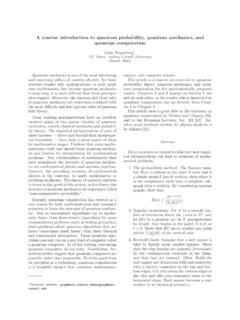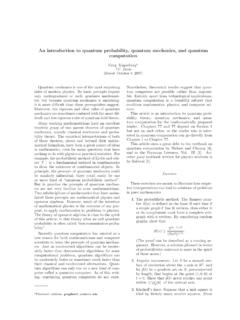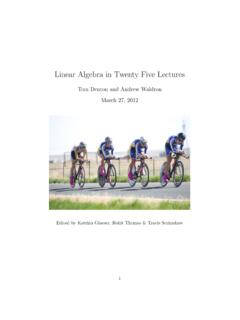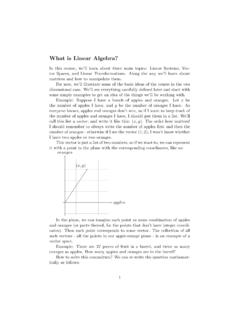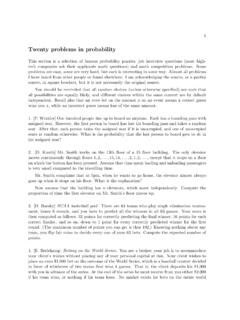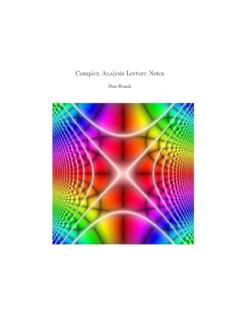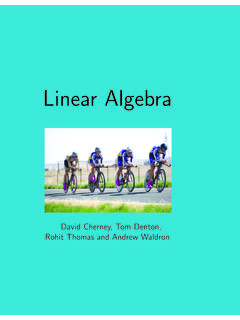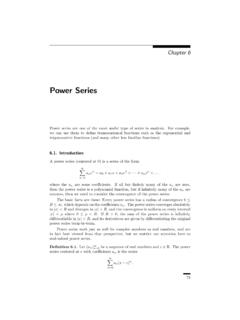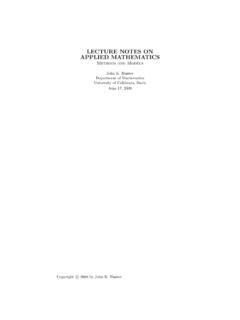Transcription of Measure Theory JohnK.Hunter
1 Measure TheoryJohn K. HunterDepartment of Mathematics, University of California at are some brief notes on Measure Theory , concentratingonLebesgue Measure onRn. Some missing topics I would have liked to have in-cluded had time permitted are: the change of variable formula for the Lebesgueintegral onRn; absolutely continuous functions and functions of boundedvari-ation of a single variable and their connection with Lebesgue-Stieltjes measuresonR; Radon measures onRn, and other locally compact Hausdorff topologicalspaces, and the Riesz representation theorem for bounded linear functionalson spaces of continuous functions; and other examples of measures, includingk-dimensional Hausdorff Measure inRn, Wiener Measure and Brownian mo-tion, and Haar Measure on topological groups.
2 All these topics can be foundin the John K. Hunter, 2011 ContentsChapter 1. Topological Extended real Outer Sets of Measure zero6 Chapter 2. Lebesgue Measure Lebesgue outer Outer Measure of Carath eodory Null sets and Translational Borel Borel Linear Lebesgue-Stieltjes measures30 Chapter 3. Measurable Real-valued Pointwise Simple Properties that hold almost everywhere38 Chapter 4. Simple Positive Measurable Absolute Convergence Complex-valued functions and Riemann Integrals of vector-valued functions52 Chapter 5. Product Product Product Measurable Monotone class Fubini s Completion of product measures61 Chapter 6.
3 A covering Maximal Hardy-Littlewood Lebesgue differentiation Signed Hahn and Jordan Radon-Nikodym Complex measures77 Chapter Minkowski and H older Duality83 Bibliography89 CHAPTER 1 MeasuresMeasures are a generalization of volume; the fundamental exampleis Lebesguemeasure onRn, which we discuss in detail in the next Chapter. Moreover, asformalized by Kolmogorov (1933), Measure Theory provides the foundation of prob-ability. Measures are important not only because of their intrinsic geometrical andprobabilistic significance, but because they allow us to define connection, in fact, goes in both directions: we can define an integralin terms of a Measure ; or, in the Daniell-Stone approach, we can start with anintegral (a linear functional acting on functions) and use it to define a Measure .
4 Inprobability Theory , this corresponds to taking the expectation ofrandom variablesas the fundamental concept from which the probability of events these notes, we develop the Theory of measures first, and then define is (arguably) the more concrete and natural approach; it is also (unarguably)the original approach of Lebesgue. We begin, in this Chapter, with some prelimi-nary definitions and terminology related to measures on arbitrary sets. See Folland[4] for further SetsWe use standard definitions and notations from set Theory and will assume theaxiom of choice when needed. The words collection and family are synonymouswith set we use them when talking about sets of sets.
5 We denote the collectionof subsets, or power set, of a setXbyP(X). The notation 2 Xis also Xand the setXis understood, we denote the complement ofEinXbyEc=X\E. De Morgan s laws state that [ IE !c=\ IEc , \ IE !c= [ IEc .We say that a collectionC={E X: I}of subsets of a setX, indexed by a setI, coversE Xif[ IE collectionCis disjoint ifE E = for 6= .The Cartesian product, or product, of setsX,Yis the collection of all orderedpairsX Y={(x,y) :x X,y Y}.121. Topological spacesA topological space is a set equipped with a collection of open subsetsthatsatisfies appropriate topological space (X,T) is a setXand a collectionT P(X) of subsets ofX, called open sets, such that(a) ,X T;(b) if{U T: I}is an arbitrary collection of open sets, then theirunion[ IU Tis open;(c) if{Ui T:i= 1,2.]]]]}
6 ,N}is a finite collection of open sets, then theirintersectionN\i=1Ui Tis complement of an open set inXis called a closed set, andTis called a Extended real numbersIt is convenient to use the extended real numbersR={ } R { }.This allows us, for example, to talk about sets with infinite Measure ornon-negativefunctions with infinite integral. The extended real numbers are totally ordered inthe obvious way: is the largest element, is the smallest element, and realnumbers are ordered as inR. Algebraic operations onRare defined when they +x= for everyx Rexceptx= , but define a topology onRin a natural way, makingRhomeomorphic to acompact interval. For example, the function :R [ 1,1] defined by (x) = 1ifx= x/ 1 +x2if < x < 1ifx= is a primary reason to use the extended real numbers is that upper and lowerbounds always exist.
7 Every subset ofRhas a supremum (equal to if the subsetcontains or is not bounded from above inR) and infimum (equal to if thesubset contains or is not bounded from below inR). Every increasing sequenceof extended real numbers converges to its supremum, and everydecreasing sequenceconverges to its infimum. Similarly, if{an}is a sequence of extended real-numbersthenlim supn an= infn N supi nai ,lim infn an= supn N infi nai both exist as extended real OUTER MEASURES3 Every sumP i=1xiwith non-negative termsxi 0 converges inR(to ifxi= for somei Nor the series diverges inR), where the sum is defined by Xi=1xi= sup(Xi Fxi:F Nis finite).As for non-negative sums of real numbers, non-negative sums ofextended realnumbers are unconditionally convergent (the order of the terms does not matter);we can rearrange sums of non-negative extended real numbers Xi=1(xi+yi) = Xi=1xi+ Xi=1yi;and double sums may be evaluated as iterated single sums Xi,j=1xij= sup X(i,j) Fxij:F N Nis finite = Xi=1 Xj=1xij = Xj=1 Xi=1xij!
8 Our use of extended real numbers is closely tied to the order and monotonicityproperties ofR. In dealing with complex numbers or elements of a vector space,we will always require that they are strictly Outer measuresAs stated in the following definition, an outer Measure is a monotone,countablysubadditive, non-negative, extended real-valued function defined on all subsets ofa outer Measure on a setXis a function :P(X) [0, ]such that:(a) ( ) = 0;(b) ifE F X, then (E) (F);(c) if{Ei X:i N}is a countable collection of subsets ofX, then [i=1Ei! Xi=1 (Ei).We obtain a statement about finite unions from a statement about infiniteunions by taking all but finitely many sets in the union equal to the empty that is not assumed to be additive even if the collection{Ei}is -algebrasA -algebra on a setXis a collection of subsets of a setXthat contains andX, and is closed under complements, finite unions, countable unions, and -algebra on a setXis a collectionAof subsets ofXsuchthat:(a) ,X A;(b) ifA AthenAc A;(c) ifAi Afori Nthen [i=1Ai A, \i=1Ai de Morgan s laws, a collection of subsets is -algebra if it contains andis closed under the operations of taking complements and countableunions (or,equivalently, countable intersections).]]
9 A set, then{ ,X}andP(X) are -algebras onX; theyare the smallest and largest -algebras onX, spaces provide the domain of measures, defined measurable space (X,A) is a non-empty setXequippedwith a is useful to compare the definition of a -algebra with that of a topology inDefinition There are two significant differences. First, the complement of ameasurable set is measurable, but the complement of an open set is not, in general,open, excluding special cases such as the discrete topologyT=P(X). Second,countable intersections and unions of measurable sets are measurable, but onlyfinite intersections of open sets are open while arbitrary (even uncountable) unionsof open sets are open.
10 Despite the formal similarities, the properties of measurableand open sets are very different, and they do not combine in a straightforward any collection of subsets of a setX, then there is a smallest -algebraonXthat containsF, denoted by (F). any collection of subsets of a setX, then the -algebragenerated byFis (F) =\{A P(X) :A FandAis a -algebra}.This intersection is nonempty, sinceP(X) is a -algebra that containsF, andan intersection of -algebras is a -algebra. An immediate consequence of thedefinition is the following result, which we will use a collection of subsets of a setXsuch thatF AwhereAis a -algebra onX, then (F) the most important -algebras are the Borel -algebras on (X,T) be a topological space.

